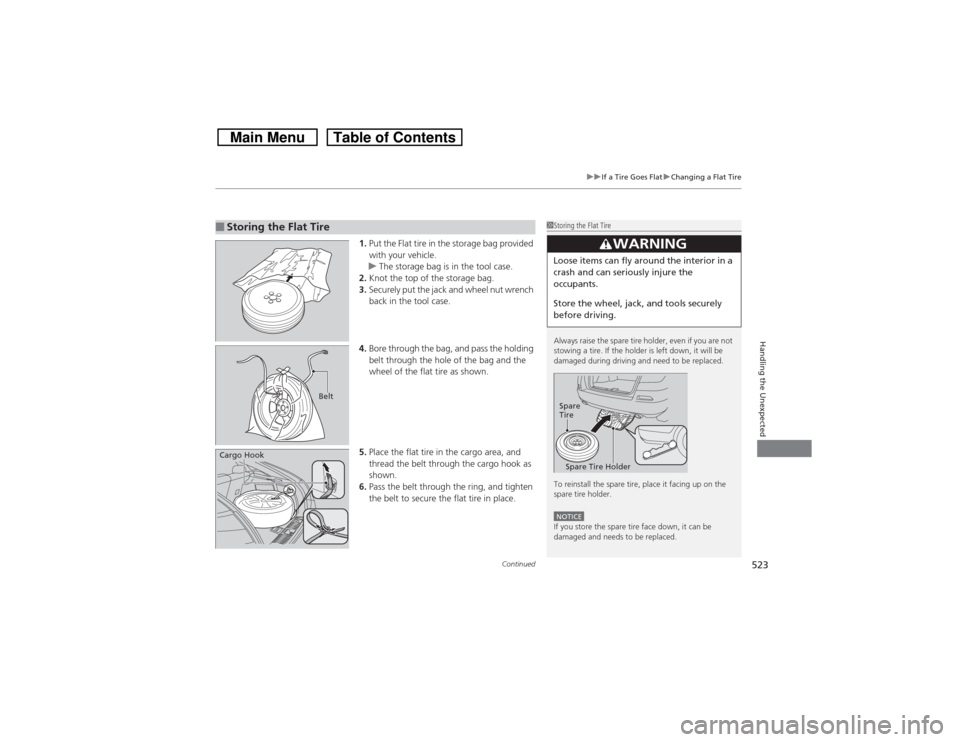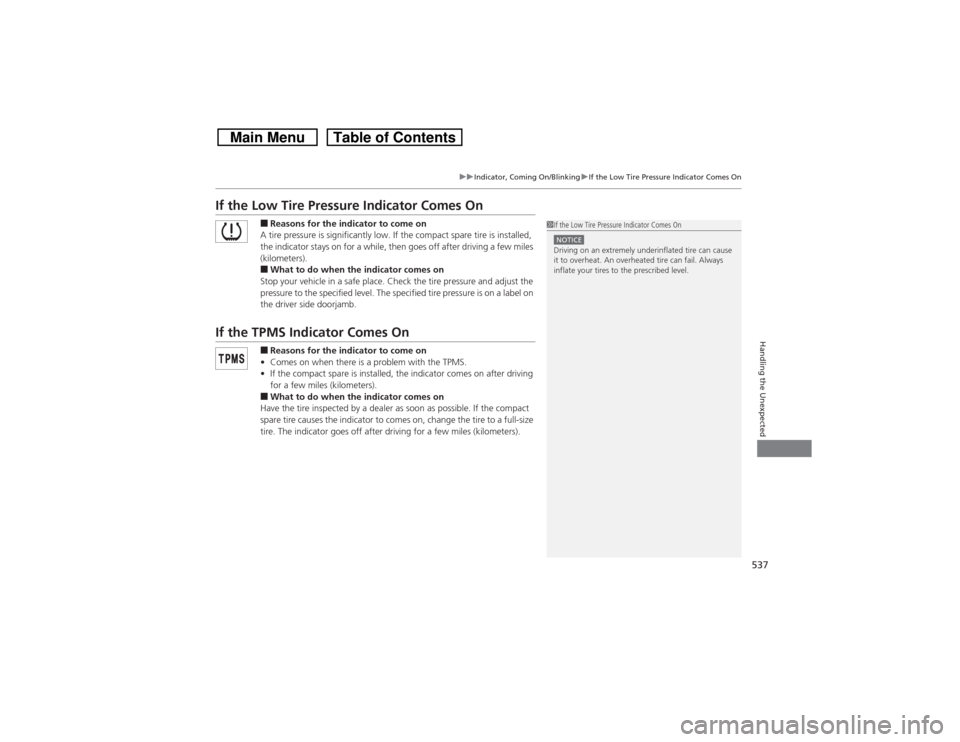Page 520 of 573
Continued
519
uuIf a Tire Goes FlatuChanging a Flat Tire
Handling the Unexpected
5.Remove the cover on the cargo area lining
to access the shaft for the spare tire hoist.
6.Attach the short end of the wheel nut
wrench to the spare tire holder shaft.
Turn the wrench to the left to loosen the
shaft.
7.Attach the longer section of the wrench to
the shaft, and turn it until you can see the
spare tire.
uDo not turn the wrench any further
once you feel resistance.
8.Lift up the spare tire holder, then slide the
hook to lift down the holder.
9.Remove the spare tire from the holder.
1Changing a Flat TireNOTICEThe wheel nut wrench supplied with your vehicle is
specially adapted to fit the holder shaft. Do not use
any other tool.
Cover
Wheel Nut Wrench
Spare Tire
Page 521 of 573
520
uuIf a Tire Goes FlatuChanging a Flat Tire
Handling the Unexpected
10.Place a wheel block or rock in front and
rear of the wheel diagonal to the flat tire.
11.Place the compact spare tire (wheel side
up) under the vehicle body, near the tire
that needs to be replaced.
12.Loosen each wheel nut about one turn
using the wheel nut wrench.
Wheel
Blocks
The tire to be replaced.
Page 523 of 573
uuIf a Tire Goes FlatuChanging a Flat Tire
522Handling the Unexpected
1.Remove the wheel nuts and flat tire.
2.Wipe the mounting surfaces of the wheel
with a clean cloth.
3.Mount the compact spare tire.
4.Screw the wheel nuts until they touch the
lips around the mounting holes, and stop
rotating.
5.Lower the vehicle and remove the jack.
Tighten the wheel nuts in the order
indicated in the image. Go around,
tightening the nuts, two to three times in
this order.
Wheel nut torque:
80 lbf∙ft (108 N∙m, 11 kgf∙m)
■Replacing the Flat Tire
1Replacing the Flat Tire
Do not over tighten the wheel nuts by applying extra
torque using your foot or a pipe.
Page 524 of 573

Continued
523
uuIf a Tire Goes FlatuChanging a Flat Tire
Handling the Unexpected
1.Put the Flat tire in the storage bag provided
with your vehicle.
uThe storage bag is in the tool case.
2.Knot the top of the storage bag.
3.Securely put the jack and wheel nut wrench
back in the tool case.
4.Bore through the bag, and pass the holding
belt through the hole of the bag and the
wheel of the flat tire as shown.
5.Place the flat tire in the cargo area, and
thread the belt through the cargo hook as
shown.
6.Pass the belt through the ring, and tighten
the belt to secure the flat tire in place.
■Storing the Flat Tire
1Storing the Flat Tire
Always raise the spare tire holder, even if you are not
stowing a tire. If the holder is left down, it will be
damaged during driving and need to be replaced.
To reinstall the spare tire, place it facing up on the
spare tire holder.NOTICEIf you store the spare tire face down, it can be
damaged and needs to be replaced.
3
WARNING
Loose items can fly around the interior in a
crash and can seriously injure the
occupants.
Store the wheel, jack, and tools securely
before driving.Spare
Tire
Spare Tire Holder
Belt
Cargo Hook
Page 525 of 573
uuIf a Tire Goes FlatuChanging a Flat Tire
524Handling the Unexpected
If you replace a flat tire with the spare tire, the low tire pressure indicator comes on
while you are driving. After driving for a few miles (kilometers), the indicator will go
off and the TPMS indicator comes on, but this is normal.
If you replace the tire with a specified regular tire, the low tire pressure or TPMS
indicator will go off after a few miles (kilometers).■TPMS and the Spare Tire
1TPMS and the Spare Tire
The system cannot monitor the pressure of the spare
tire. Manually check the spare tire pressure to be sure
that it is correct.
Use TPMS specific wheels. Each is equipped with a
tire pressure sensor mounted inside the tire behind
the valve stem.
Page 538 of 573

537
uuIndicator, Coming On/BlinkinguIf the Low Tire Pressure Indicator Comes On
Handling the Unexpected
If the Low Tire Pressure Indicator Comes On
■Reasons for the indicator to come on
A tire pressure is significantly low. If the compact spare tire is installed,
the indicator stays on for a while, then goes off after driving a few miles
(kilometers).■What to do when the indicator comes on
Stop your vehicle in a safe place. Check the tire pressure and adjust the
pressure to the specified level. The specified tire pressure is on a label on
the driver side doorjamb.
If the TPMS Indicator Comes On
■Reasons for the indicator to come on
•Comes on when there is a problem with the TPMS.
•If the compact spare is installed, the indicator comes on after driving
for a few miles (kilometers).■What to do when the indicator comes on
Have the tire inspected by a dealer as soon as possible. If the compact
spare tire causes the indicator to comes on, change the tire to a full-size
tire. The indicator goes off after driving for a few miles (kilometers).
1If the Low Tire Pressure Indicator Comes OnNOTICEDriving on an extremely underinflated tire can cause
it to overheat. An overheated tire can fail. Always
inflate your tires to the prescribed level.
Page 548 of 573
547
uuSpecificationsu
Continued
Information
■Brake Fluid
■Automatic Transmission Fluid
■Power Steering FluidSpecified
Honda Heavy Duty Brake Fluid DOT 3
Specified
Honda ATF DW-1
(automatic transmission fluid)
Capacity Change 2.6 US qt (2.5 ℓ)
Specified
Honda Power Steering Fluid
■Engine Oil
■Engine CoolantRecommended
·Genuine Honda Motor Oil 0W-20
·API Premium-grade 0W-20 detergent oil
CapacityChange 4.0 US qt (3.8 ℓ)
Change
including
filter4.2 US qt (4.0 ℓ)
Specified
Honda Long-Life Antifreeze/Coolant Type2
Ratio 50/50 with distilled water
Capacity
1.66 US gal (6.3 ℓ)
(change including the remaining 0.18 US gal
(0.68 ℓ) in the reserve tank)
■TireRegular
Size
225/65R17 102T
Pressure
psi (kPa [kgf/cm
2])
Front
32 (220 [2.2])
Rear
32 (220 [2.2])
Compact
SpareSize T155/90D16 110M
Pressure
psi (kPa [kgf/cm
2])60 (420 [4.2])
Wheel Size
Regular
17 x 6 1/2J
Compact Spare
16 x 4T
Page 550 of 573

549
uuSpecificationsu
Information
■Brake Fluid
■Automatic Transmission Fluid
■Rear Differential Fluid
■Transfer Assembly FluidSpecified
Honda Heavy Duty Brake Fluid DOT 3
Specified
Honda ATF DW-1
(automatic transmission fluid)
Capacity Change 3.28 US qt (3.1 ℓ)
Specified
Honda Dual Pump Fluid II
Capacity Change 1.3 US qt (1.2 ℓ)
Specified
·SAE 90 Viscosity Hypoid Gear Oil
·API Service Classified GL4 or GL5 only
Capacity Change 0.43 US qt (0.41 ℓ)
■Engine Oil
■Engine CoolantRecommended
·Genuine Honda Motor Oil 0W-20
·API Premium-grade 0W-20 detergent oil
CapacityChange 4.2 US qt (4.0 ℓ)
Change
including
filter4.5 US qt (4.3 ℓ)
Specified
Honda Long-Life Antifreeze/Coolant Type2
Ratio 50/50 with distilled water
Capacity
1.92 US gal (7.3 ℓ)
(change including the remaining 0.17 US gal
(0.64 ℓ) in the reserve tank)
■Tire*1: 2WD models
*2: 4WD modelsRegular
Size
225/60R18 100H
Pressure
psi (kPa [kgf/cm
2])
33 (230 [2.3])
FrontRear
33 (230 [2.3])
Compact
SpareSizeT155/90D16 110M
*1
T155/90D17 101M
*2
Pressure
psi (kPa [kgf/cm
2])60 (420 [4.2])
Wheel Size
Regular
18 x 7J
Compact Spare
16 x 4T
*1
17 x 4T
*2